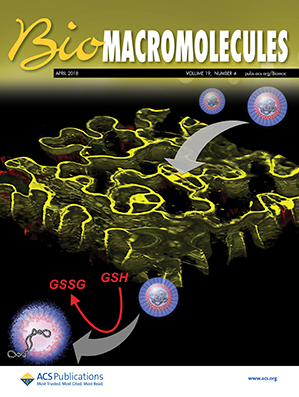设计和合成可水解降解聚乙二醇氨基甲酸酯、碳酸酯和酯衍生物诱导可逆生物停滞。
IF 5.4
2区 化学
Q1 BIOCHEMISTRY & MOLECULAR BIOLOGY
引用次数: 0
摘要
控制水凝胶的网络化学和连通性对于产生可调材料特性至关重要,包括用于组织支架和药物输送等应用的材料降解。本文研究了生理条件下苯酰胺和丁香酸衍生氨基甲酸酯、曲酸衍生碳酸酯和曲酸衍生酯等不同水解可切割基团的水凝胶的降解。水凝胶网络降解的可调性通过改变水解可降解的部分、大分子的功能以及与水解稳定的大分子的共聚来证明。这些水解不稳定的大分子被引入细胞内交联,诱导MCF10A细胞的短暂细胞静止,导致一个高度可调的降解机制,能够诱导细胞的可逆生物停滞,60%的细胞经过碳酸盐大分子处理后,在72小时后恢复到增殖状态并恢复翻译活性。而氨基甲酸酯大分子处理细胞的生物活性仍然受到抑制。本文章由计算机程序翻译,如有差异,请以英文原文为准。
Design and Synthesis of Hydrolytically Degradable PEG Carbamate, Carbonate, and Ester Derivatives to Induce Reversible Biostasis
Control over network chemistry and connectivity of hydrogels is critical for the generation of tunable material properties, including material degradation for applications such as tissue scaffolding and drug delivery. Here, the degradation of hydrogels employing different hydrolytically cleavable groups including benzamide and syringic acid-derived carbamates, kojic acid-derived carbonates, and kojic acid-derived esters under physiological conditions was studied. Tunability of the hydrogel network degradation was demonstrated by varying the hydrolytically degradable moiety, macromer functionality, and copolymerization with hydrolytically stable macromers. These hydrolytically labile macromers were introduced and cross-linked intracellularly to induce transient cellular quiescence in MCF10A cells, resulting in a highly tunable degradation mechanism that is shown to be capable of inducing reversible biostasis of cells with 60% of cells treated with the carbonate macromer returning to their proliferative state and rebounding in translational activity after 72 h, while the biological activity of the carbamate macromer-treated cells remained suppressed.
- Download: Download high-res image (73KB)
- Download: Download full-size image
求助全文
通过发布文献求助,成功后即可免费获取论文全文。
去求助
来源期刊

Biomacromolecules
化学-高分子科学
CiteScore
10.60
自引率
4.80%
发文量
417
审稿时长
1.6 months
期刊介绍:
Biomacromolecules is a leading forum for the dissemination of cutting-edge research at the interface of polymer science and biology. Submissions to Biomacromolecules should contain strong elements of innovation in terms of macromolecular design, synthesis and characterization, or in the application of polymer materials to biology and medicine.
Topics covered by Biomacromolecules include, but are not exclusively limited to: sustainable polymers, polymers based on natural and renewable resources, degradable polymers, polymer conjugates, polymeric drugs, polymers in biocatalysis, biomacromolecular assembly, biomimetic polymers, polymer-biomineral hybrids, biomimetic-polymer processing, polymer recycling, bioactive polymer surfaces, original polymer design for biomedical applications such as immunotherapy, drug delivery, gene delivery, antimicrobial applications, diagnostic imaging and biosensing, polymers in tissue engineering and regenerative medicine, polymeric scaffolds and hydrogels for cell culture and delivery.
 求助内容:
求助内容: 应助结果提醒方式:
应助结果提醒方式:


